Halawet el Jibn is an exquisite dessert of semolina and cheese rolls topped with rose or orange scented sugar syrup, and is simply perfect for any occasion.
Estimated reading time: 9 minutes

Halawet el Jibn
Let’s look at the name first, shall we? In Arabic:
- halawet = sweet, sweetness, dessert, along those lines
- el = the (definite article)
- jibn = cheese
So, Halawet el Jibn can be translated as sweetness of the cheese. Or simply, sweet cheese, or even cheese dessert.
Pronunciation
- Halawat = all the syllables are pronounced with the ah sound (silent h).
- el – also the same vowel sound, so like the u sound in mull.
- Jibn – just imagine there is an e between the letters b and n, so ji-ben (as in burn, silent r).
Sweet cheese, you might think. But hey, don’t forget cheesecakes, they are sweet cheese confections, aren’t they? Also, if you’ve been a long time follower of LinsFood, you’ll be familiar with Kunafeh, that other Middle Eastern sweet cheese dessert.
Halawet el Jibn comes from the city of Hama in Syria. Like many other Levantine and Middle Eastern dessert, it has long been a favourite all over the region, even finding its way to the Mediterranean.
It is a must have recipe during Ramadan and for some people, Eid. And because Syria has a sizeable number of Catholics, it is also a recipe for Easter, for many families.
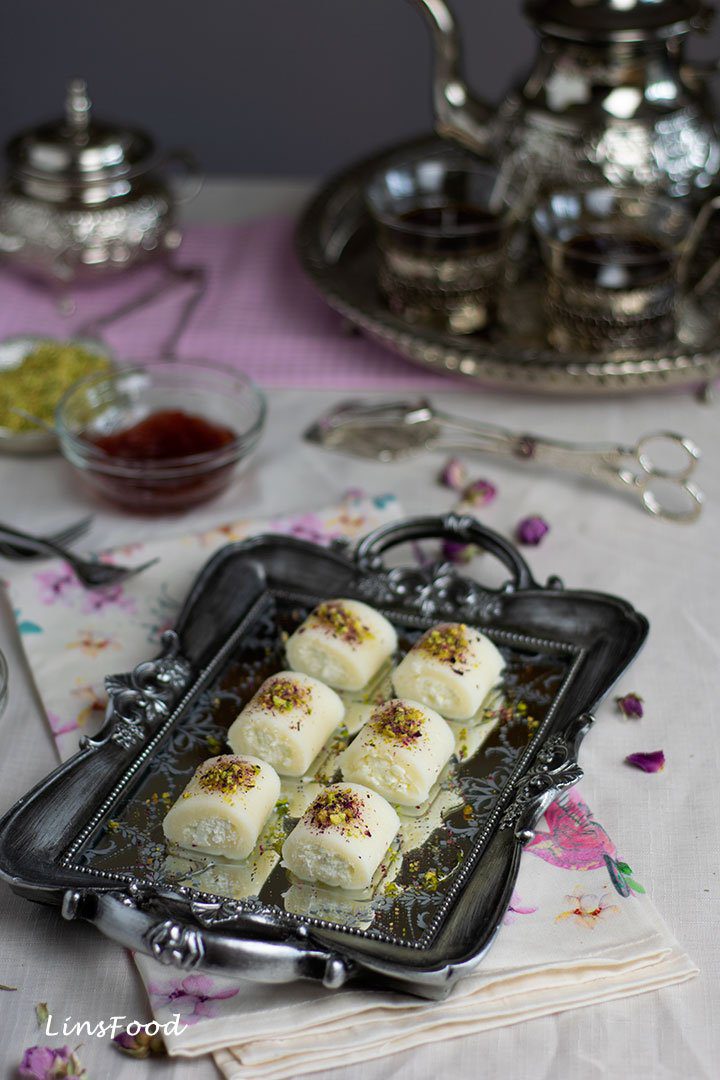
How to make Halawet el Jibn
Making Halawet el Jibn is a fairly straightforward process, even if it does include a little elbow grease, in the making of the semolina-cheese dough. Just like making choux pastry. This is what we’ll be doing:
- Make the rose or orange scented sugar syrup, and leave to cool (no more than 10 minutes).
- Make the cheese dough with water, sugar, fine semolina, mozzarella (traditionally, akkawi) and rose or orange flower water (10 minutes).
- Roll out the semolina-cheese dough and fill with ashta (Middle Eastern clotted cream) or to make it easier, mascarpone cheese, roll into logs and cut (30 minutes for the amount here).
- Drizzle the sugar syrup all over and top with crushed pistachios and crushed rose petals or rose petal jam (5 minutes)
Those are the steps involved. The only part that a first timer may struggle with, is the actual rolling of the dough into logs, as the dough can be a little sticky. This can be solved with using clingfilm to roll and handle the dough or rubbing a tiny amount of tasteless vegetable oil on your hand. You could even use disposable kitchen gloves for this part to stop the dough from sticking to your hands.
Sticky, Mushy Dough?
One of my readers had trouble with the dough, it was just too sticky and mushy.
- It’s very important to cook the semolina and cheese dough well. Once it comes away from the edges of the pan, keep cooking it for another good 10 seconds.
- If your dough is too mushy or sticky to work with, put it back in the pan, heat it gently on low heat, and add 1 tsp of semolina and keep stirring. Keep adding the semolina, 1 tsp at a time, until you have a dough that is workable and not mushy.
You shouldn’t need more than 2-3 tsp.

Halawet el Jibn Recipe
There are a couple of ingredients here that are not going to be easily available to many people, and that’s the cheese for the dough, as well as the cream that is traditionally used to fill the rolls, ashta (aka eshta). So let’s take a look at them, and the substitutes you can use, to make your life easier.
The Cheese for Halawet el Jibn
Traditionally, the cheese used for the semolina dough is akkawi and madjouli. Both are salty and stretchy cheeses.
They need to be soaked and desalted before being used in sweet desserts, which is not really a big deal. The trouble is finding it if you don’t commonly have access to “exotic” ingredients. I’m in the UK, and extremely lucky to have access to all kinds of stuff, spanning the globe. Many, in our local supermarkets, without having to go online.
However, madjoul is virtually impossible, and akkawi is still a bit of a hit and miss. Sometimes, I’ll find it in the local Persian grocer, some 10 minutes away. Sometimes, I can find it online. And the other third of the time (usually when I really, really need it for clients), not a hope in hell.
Mozzarella is a great substitute for Akkawi
So, the next best thing? Mozarella, the perfect akkawi substitute for our halawet el jibn, kunafeh, and any other akkawi based desserts.
If you can, get the harder mozzarella. It will produce a slightly sturdier dough.
It is also a little salty, so you could desalt it before use, if you like. In fact, in the kunafeh recipe here, I suggest doing that. But I’ve long dispensed with the soaking of the mozzarella, just need to update that kunafeh recipe! All I do, is up the sugar level ever so slightly to compensate. The salt in the mozzarella is a great addition to the flavours of your recipe.
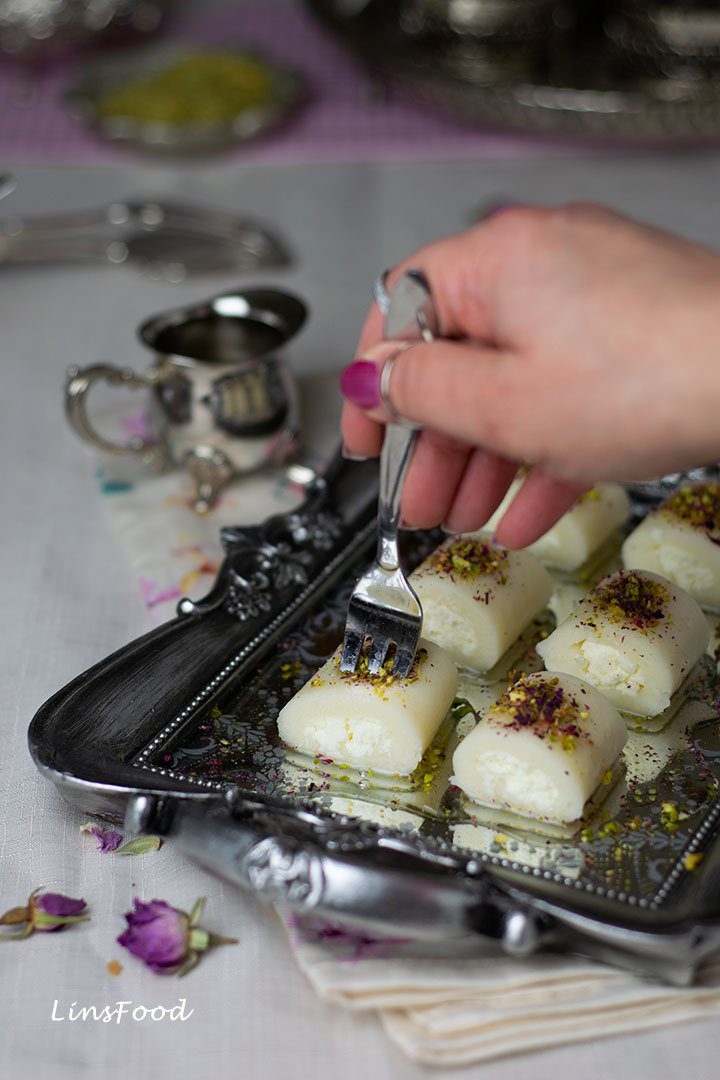
Halawet el Jibn Cream Filling
So traditionally, the semolina-cheese dough is filled with ashta, the Middle Eastern clotted cream. It started out life as having been made lovingly and patiently by skimming off the skin on boiling milk, again and again until you have enough, and then clotted with vinegar or lemon juice.
These days, there are many ways of making ashta at home, although if you are in the Middle East somewhere, it’s hardly worth the bother, as you can get the real thing easily in your local shops.
Ashta is easily made with boiling some milk, curdling it with vinegar or lemon juice, then thickening it with some cornflour, or even crustless bread. Then you just whip it smooth, if you like, and flavour with rose or orange blossom water.
Click here for our homemade ashta recipe.
However, if you don’t fancy making ashta from scratch, my favourite ashta substitute is mascarpone – one of the best dessert ingredients that ever lived! I’ve given it as a substitute in the recipe card below.
Mascarpone has such a creamy, well rounded flavour that makes it the perfect (better?) substitute for cream in any situation.

Toppings for the Semolina Cheese Rolls
The sweet cheese rolls are fairly bland on their own, with just a hint of sweet and flower power. It is the drizzle of the sugar syrup and the toppings that complete halawet el jibn. This combination of pistachios and flower water is a very, very traditional combination when it comes to desserts throughout the Middle East.
Let’s take a look at how we’ll be topping them.
Ground Pistachios
The ground pistachios add not only a pop of colour but also, a creamy nutty layer of flavour. You don’t need much, just a tablespoon or two.
I prefer to grind the pistachios myself, instead of buying them ground, for a fresher taste.
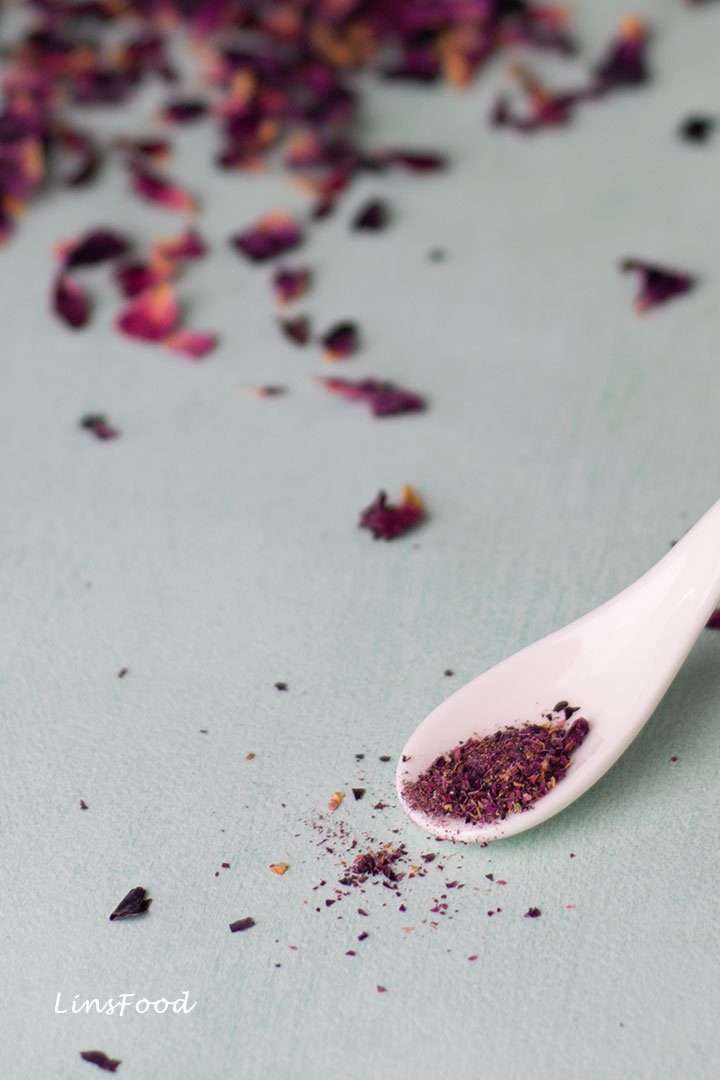
Ground Dried, Edible Rose Petals
Edible rose petals are a favourite ingredient of mine, in both sweet and savoury recipes. These are easily bought online and at specialist shops. If you are in the UK, Waitrose stocks them.
Otherwise, you know Amazon does, click here for the ones I use (affiliate link).
Dried edible rose petals are best used crushed, or ground to a fairly fine state. This way, they become part of the recipe, and you get to enjoy the aroma and flavour without having to bite into a paper-like, damp piece that doesn’t particularly taste great! That’s the only way I can think to describe it!
All I do is place them in my coffee/spice mill and blitz them. They last indefinitely, although after a few months, you’ll probably notice a marked decrease in aroma. Store them like you would any spice, covered, and out of light.
Rose Petal Jam
This adds a lovely, reddish pink look on your halawet el jibn. Rose petal jam is a rather delicious jam that smells and tastes like roses. In the summer, when our organic roses are in full bloom, some of the red ones answer to a higher calling, and get turned into rose water, rose syrup and rose jam.
However, if I need rose petal jam out of season, this is the one I get on Amazon (affiliate link).
And here’s my homemade rose petal jam recipe, if like me, you love flexing those culinary muscles!
I must confess though that I prefer having halawet el jibn without the rose petal jam. Which might explain why I forgot to top them for the photoshoot! 🤦♀️
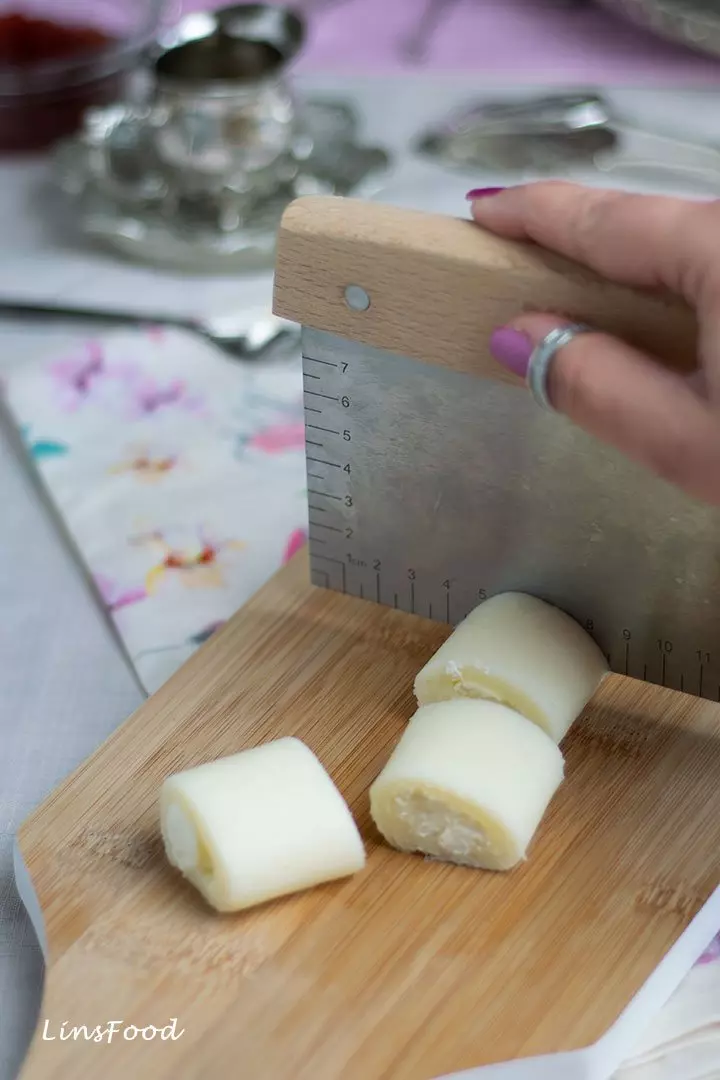
How long will Halawet el Jibn Keep?
Any extra can be kept in the fridge in an airtight container. Halawet el Jibn will keep happily in the fridge for 5 days. In fact, I rather think the flavour improves on the second day. But like cheesecakes, their freshness is at its peak in the first 3 days.
You can serve these sweet cheese rolls straight out of the fridge if you like, something I personally love. Or, you can leave them out for 30 minutes, to come to room temperature, before serving.
So there you have it, a delicious recipe to try out soon and wow your guests. Shall we get our aprons on?
If you enjoy the recipe, drop me a comment and let me know. And if you are feeling like a star, don’t forget that 5-star rating! Shukran!
And if you make the recipe, share it on any platform and tag me @azlinbloor, and hashtag it #linsfood
Lin xx
More Middle Eastern Desserts


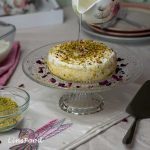

Halawet el Jibn (Levantine Sweet Cheese and Semolina Rolls)
Equipment
- weighing scales
- saucepans (1 small, 1 medium)
- ladles and spoons
- piping bag
- chopping board or tray
- Rolling Pin
- knife or pizza wheel
Ingredients
Halawet el Jibn Syrup
- 250 ml water
- 400 g sugar
- 1 Tbsp rose water OR orange flower water (whichever you prefer), but not both together, as the orange will obscure the musky, and lighter rose
Semolina and Cheese Dough
- ⅛ tsp ground cardamom seeds (or a generous pinch) the seeds of about 8 cardamoms
- 200 g fine semolina
- 350 ml water
- 200 g white sugar
- 300 g mozzarella grated or, if using the soft kind, chopped to small pieces, so they melt quicker
- 1 Tbsp rose water OR orange flower water (my advice is to stick to one for the whole recipe)
Halawet el Jibn Filling
- 400 g homemade ashta OR mascarpone
Toppings
- 50 g ground pistachios I always grind them fresh before serving
- 1 Tbsp crushed dried edible rose petals see post for explanation
- rose petal jam as needed (optional, as may not be easy to find)
Instructions
Halawet el Jibn Syrup
- Heat the water and sugar in a small saucepan and bring to a simmer. Lower the heat right down and simmer for 5 minutes.

- When done, remove from the heat and leave to cool for 10 minutes before stirring in the rose water or orange flower water. Leave to cool completely before drizzling on the sweet cheese rolls. Can also be refrigerated for a cold syrup, but it will get very thick.Can be made up to a week ahead, and stored in the fridge, covered.

Semolina and Cheese Dough
- Sprinkle the ground cardamom over the semolina and mix a little.
- Place the water and sugar in a medium saucepan on high heat (about 20cm in diameter) and bring to a boil.
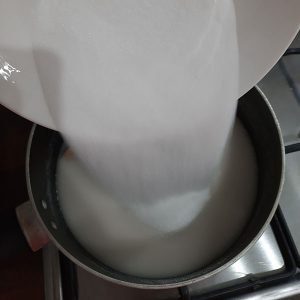
- Lower the heat to medium and slowly, sprinkle the fine semolina over the water STIRRING CONSTANTLY. Mix for about 20 seconds.This may be tricky for some, as the semolina can get lumpy if not stirred constantly, as it's being added.In my Middle Eastern desserts class, I get my students to mix the water, sugar and semolina in a cold saucepan before placing it on medium-high heat. Then stir regularly. After about 2 minutes, it'll start to thicken, at which point, we add the cheese (next step).

- After 20 seconds, tip in the cheese and rose water, and continue stirring. This part does get a little tiring, but it has to be done. Keep stirring until it becomes one big lump of dough, and is coming away from the saucepan, just like choux pastry.It's very important that you give the dough enough time here, to cook. Keep stirring it round and round for 10 more seconds, after it comes away clean from the edges. Otherwise, your dough may be too sticky to work with.

- Take it off the heat and leave to cool for about 20 minutes, until your hands can handle it.

Assembling Halawet el Jibn
- Tip the dough out onto a large chopping board or a clean work surface. Divide it into 3 portions. Cover 2 of them with a damp cloth while you work with one.
- Place a clingfilm on your work surface, then place the semolina-cheese dough on it. Cover with another sheet of clingfilm and roll the dough out with a rolling pin into a rectangle, measuring about 33cm by 25cm (10" x 13").The clingfilm will prevent your dough from sticking, this is something I do with most pastry work, as you'll know from the other recipes on this site.

- Using a knife or pizza wheel, cut off the edges of the rough edges so you get a neat rectangle. Add these cut offs to the two portions of dough.

- Fill the piping bag with the mascarpone about halfway up. Snip off about 2.5cm (1") off the end.
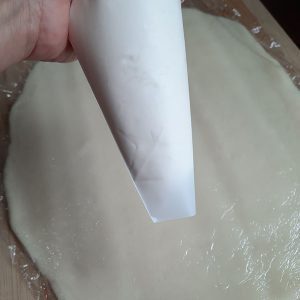
- Pipe out the mascarpone along the edge of the semolina dough that's closest to you. Leave about 1cm (½") of space from the edge.
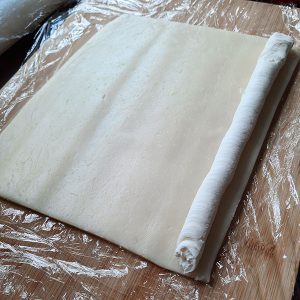
- Now we'll roll the dough up to form a log, like when we make sausage rolls. You can do one of 2 things:1. Roll the dough up with the clingfilm until the mascarpone is completely covered in the dough, with the seam at the bottom. OR2. Lightly oil your hands with the flavourless vegetable oil, and roll the dough up without the clingfilm.
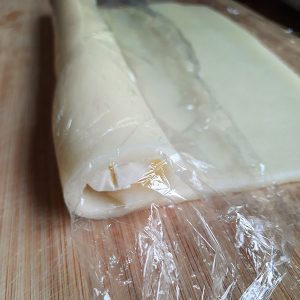
- Then, using a knife or pizza wheel, cut along the edge of the log to "release" it from the rest of the dough. Carefully lift the log up and set it aside on a baking sheet. Be careful, it is fairly soft and may stretch.I just cut a length of clingfilm and wrap it along the log and twist the ends, then lift the log up to set it aside.

- You should be left with half the rolled out dough to form another log.Get the piping bag of mascarpone and pipe out another length along the edge of the second half of your rolled out dough. Repeat the above step. So roll your dough up to form a log, with the mascarpone fully sandwiched in the dough. Set aside.
- Repeat with the other 2 portions. You will end up with 6-7 logs, depending on the lengths.
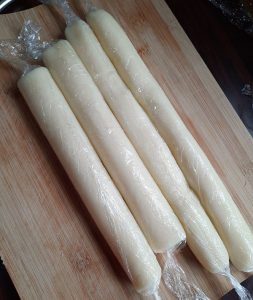
Serving Halawet el Jibn
- Cut up the logs into little pieces, about 5cm (2") long, and arrange them on a serving plate. Be sure to wipe your knife between each cut so as not to leave bits of cheese on the next cut. Just like when slicing cheesecakes.

- Drizzle the sugar syrup all over the cut pieces. Then, top with pistachios and rose petals or jam. Leave the syrup on the table for anyone who wants more.Any extra will keep, covered, in the fridge for up to 5 days. If you don't finish them up, that is! You can serve them straight out of the fridge, or leave to come to room temperature for about 3o minutes, if you like. I love them cold.

I was a bit surprised they were not baked after rolling
I will DEFINETLY be trying these soon
Thank you for sharing your knowledge with us! I love the way you give so much information, not simply a recipe & how to
My pleasure, Gee. I’m pleased to hear that you enjoy the additional information I love to provide. I think it makes us appreciate the recipe so much more.
Hello! I made this today and although I have made halewet el jeben before I did struggle with the dough. I can’t seem to get it to a “dough” consistency, even after having measured the ingredients exactly and following the steps religiously. It just stays as a sort of mush! Any idea how I can fix this? Thanks!
Hi Taline, that must be so frustrating. 2 solutions:
1. Place the dough in the fridge for 45 minutes to harden, so you can work with it. But I’m thinking that if it’s very mushy, it still won’t keep its shape too well after assembling.
2. Best option – place it back in the saucepan and heat it gently on low heat. Then add 1 tsp of semolina at a time, stirring the semolina in to mix. The semolina will absorb the excess moisture as it mixes and cooks, so this should solve your problem.
Let me know how it goes.
Edit: like choux pastry, this wants to be cooked well on the stove, until it comes away clean from the edges. It may be that you stopped cooking a little too soon.
I’ll add this to the recipe.
My partner is of ME descent and we decide to try this recipe out of the weekend because it looks so pretty! Turned out simply amazing. What an interesting flavour and texture, the combination was a winning one! I think you have another Middle Eastern semolina pudding here, right? Going to try that one. Thanks Lin!
Hey, I am so pleased to hear that. This is one of my favourite desserts. Takes a little effort but so totally worth it! And yes, here’s the other semolina pudding: Layali Lubnan.
I’m planning to make these tomorrow for a party, wish me luck!
Good luck, let me know how it goes!
This is interesting. Is it difficult to make?
Hi Gina, if you like Middle Eastern desserts, you’ll definitely love this. It does take a bit of effort, but isn’t a difficult recipe to execute. Definitely something to make over the weekend.
Hi which brand semonila do you use?
Hi Nana, I’m actually not too bothered about the brand, as long as it’s one I recognise and can get easily. I’m in the UK, and at the moment, I have a few bags from the brand Natco. This is the Amazon link: https://amzn.to/3tET8uo
I hope that helps.
Shukran Azlin. My maman used to make these for Ramadan, but I had forgotten all about them until I saw your photo on Pinterest. I tried them this weekend, you brought tears to my eyes with the first bite, thank you so much. So easy to follow too.
Hi Soraya, I am so pleased to hear that. Glad to have been able to help and bring back memories of your maman’s cooking.
Sounds like a wonderful dessert mild sweet, creamy and cheesy. I bet they will be sticky to roll but your tips sound perfect and I will give this recipe a try soon
Thanks Indrani.
Omg !reading the recipe was a sweet torture. Absolutely delicious and love these Halawet el jibn. Sounds and looks absolutely delicious will make an awesome addition to the desserts trolley.
They certainly will. Thanks Archana.
OMG! I’m transported to some other era, some other land – a royal banquet with silver dishes, fragrance of roses and melt-in-the-mouth rich sweets! These cheese and semolina rolls are just perfect for Iftar and Eid hostess trolley.
Haha, thanks Maria, they really are rather romantic looking!
This looked so exotic and sounded so nice, I thought I’d give it a try. I’ve only had baklava as far as ME desserts go. Omg, thank you for introducing me to this amazing dessert. Everyone loved it and are asking me to make it again soon!
Hi Sue, I’m so pleased to hear that. I find this such an addictive dessert, it’s deadly!
Planning to make these tomorrow. Just have to get the mozzarella and mascarpone. Thank you Azlin for making it easier with the subs.
A pleasure, Farhana, let me know how it goes.